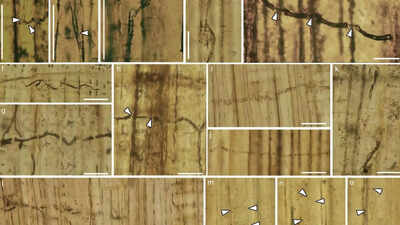160-million-year-old blue-stain fungi in China found to be harmful to trees |

In a groundbreaking discovery, researchers have uncovered 160-million-year-old blue-stain fungi fossils from the Jurassic Tiaojishan Formation in China. The new findings offer fresh insights into the ecological relationships between blue-stain fungi, plants, and insects during the Jurassic period. These fungi are generally nonfatal to their hosts but often accelerate tree mortality when associated with wood-boring insects.According to ScienceDaily, a Chinese team of scientists highlights the discovery of well-preserved blue-stain fungal hyphae within Jurassic fossil wood from northeastern China, pushing back the earliest known fossil record of this fungal group by approximately 80 million years.
Know about the blue-stain fungi, deadly to trees
Blue-stain fungi are known for their ability to colonize wood, particularly in conifer trees, causing characteristic discoloration in the sapwood. While these fungi do not decompose wood, they often cause considerable damage when associated with wood-boring insects. Their role in accelerating tree mortality is significant, yet their evolutionary origins have long remained a mystery. Molecular phylogenetic analyses suggest that blue-stain fungi are an ancient fungal group, possibly originating during the Late Paleozoic or early Mesozoic.This recent discovery in China revises our understanding of blue-stain fungi’s history, suggesting their origins trace much further back into Earth’s past.Dr. Ning Tian, a paleontologist at Shenyang Normal University, explained the rarity of such findings: “Not until 2022 was the first credible fossil record of blue-stain fungi reported from the Cretaceous in South Africa, with an age of approximately 80 million years.”
Discovery of the fossils of the blue-stain fungus
The fossils were found inside the petrified wood of Xenoxylon phyllocladoides, a type of conifer tree from the Jurassic period in western Liaoning province, China. Researchers discovered dark-colored fungal threads called hyphae, which are typical of blue-stain fungi. “Under the microscope, the fossil hyphae appear dark, showing pigmentation that is a key feature of modern blue-stain fungi, which cause wood to change color,” the team explained. This shows that these fungi have existed for millions of years and are connected to fungi we see today.The researchers also found a special structure the fungi use to enter the wood. “When the fungi penetrate the wood’s cell walls, the hyphae often form a structure called a penetration peg,” they said. This peg helps the fungi break through the tough wood cells by mechanical force, which is different from other fungi that use enzymes to break down wood.
A major leap in the fossil record of blue-stain fungi
The discovery of the blue-stain fungi found in China not only fills a gap in the fossil record but also provides critical evidence for understanding the early evolution of blue-stain fungi and their ecological interactions. The fact that these fungi were already established in the Jurassic period suggests that their relationship with wood-boring insects, which are likely the main agents for spore dispersal, was already in place long before the advent of modern insect speciesThe fossilized blue-stain fungi represent a significant milestone in paleontological research. “The finding of Jurassic blue-stain fungi from China represents the second report of the blue-stain fungi and the earliest fossil record of this fungal group in the world, pushing back the earliest known fossil record of this fungal group by approximately 80 million years,” said Dr. Yongdong Wang, a paleontologist at the Nanjing Institute of Geology and Paleontology.





